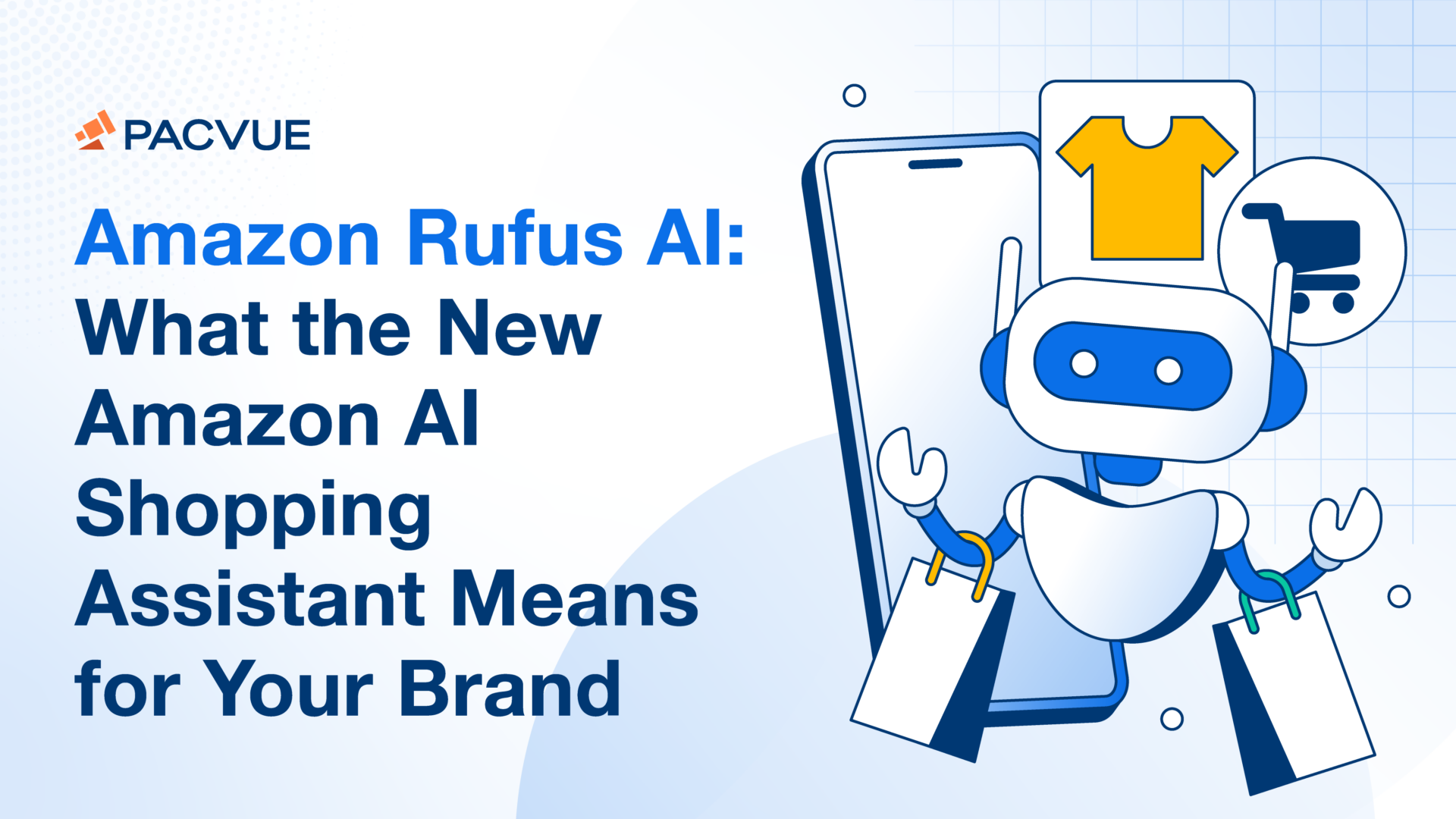In February 2024, Amazon launched Rufus, a generative AI-powered conversational shopping assistant integrated within the Amazon Shopping app. Amazon’s aim with Rufus AI is to help shoppers make better purchase decisions by answering a wide range of shopping-related questions, providing product comparisons, and making recommendations. The launch represents a powerful new avenue for shoppers to find products and, as with all big Amazon updates, offers both challenges and opportunities for brands who sell on Amazon.
How Rufus uses generative AI to create a conversational shopping experience
Amazon Rufus is designed to be more than just another AI chat bot. The key here lies in the use of generative AI, a category of AI that is capable of creating something new and totally original based on patterns learned from large sets of existing data. In Rufus’s case, the data it learns from includes:#
- Product catalog data
- Customer reviews
- Community Q&As
- Product information from across the web
Unlike traditional AI models that focus on recognizing patterns and making predictions, generative AI uses its trained data to create fresh new content, be it text, images, or even music and videos. Much like ChatGPT, which also uses generative AI, Rufus is designed to provide a conversational shopping experience by providing answers to shoppers’ questions. This includes:
- Product recommendations (What is the best running shoe for narrow feet?)
- Shopping considerations (What should I consider when shopping for an automatic coffee machine?)
- Questions about specific products (Is this toy suitable for toddlers?)
- Follow-up questions (Does this product come with a warranty?)
- Even non-shopping questions (What do I need to host a fun kids party?)
Rufus isn’t Amazon’s first foray into generative AI. The retail giant has been actively developing and integrating various generative AI tools across its platforms. You’ve probably already seen its AI-generated Review Highlights which summarizes customer reviews into short snippets, highlighting common themes and sentiments so shoppers can easily get to grips with the pros and cons of a product. Similarly in the clothing category, fit review highlights offer personalized size guidance based on aggregated customer reviews and feedback.
Amazon has also deployed generative AI to assist brands in creating more effective product listings with tools to generate titles, descriptions and bullet points based on the product’s features and customer preferences. We draw on similar technologies with Pacvue Copilot which uses generative AI to automate campaign creation for new and existing products. Here’s a small preview of what Copilot can do
How effective is Rufus at answering the questions shoppers ask?
It’s early days and we anticipate that the Rufus algorithm will evolve as the Amazon AI chatbot tests and learns the outputs that prompt shoppers to make a purchase. Still, the arrival of Rufus points to the growing impact of generative AI on the shopping experience and a potentially powerful new avenue for you to gain greater visibility of your products on Amazon.
The opportunity is greatest when your product content aligns well with common user inquiries. For example, if many shoppers are asking Rufus, “What are the best headphones for working out?” and your product description includes keywords like “best headphones for exercise”, your product is more likely to be recommended. On the other hand, if your product listing lacks these relevant keywords or descriptions, Rufus might not surface your product in response to such queries, reducing your visibility.
Three ways Amazon Rufus AI will change how you sell on Amazon
#1 PDP optimization will become more nuanced in response to AI Search
We already know that Amazon’s traditional search algorithm relies heavily on content optimization for appearance in both organic and paid search. This includes critical factors like:
- Keyword-optimized titles, product descriptions and bullets
- Listing performance factors like impressions, views, and click-through rate
- Conversion rate and product sales
These factors remain important, and if you’re already doing the hard work to optimize your PDPs for Amazon’s traditional search algorithm, then you’re already a long way towards optimizing your products for Rufus.
The twist with Rufus (and any generative AI search model) is that descriptive natural language phrases will become increasingly important for discoverability. Brands will need to evolve their keyword research to include long-tail search terms and variants that shoppers will be using in Rufus. This could include:
- Customer intent keywords (“ideal for home office”)
- Problem-solving keywords (“water-resistant for outdoor activities”)
- Performance and quality keywords (“long-lasting battery”)
- Fit and sizing keywords (“comfortable for wide feet”)
- Comparison keywords (“compared to” or “vs”)
- Question-based keywords (“How do I care for this product?”)
- Localized keywords (“What do I need to grow my favourite vegetables like courgettes and aubergines?”)
Content quality as much as quantity will rule the day with Amazon’s new AI shopping assistant. As Rufus becomes more influential in the shopper search journey, it will become crucial for you to find and fill content gaps so you can do your part to train Rufus on your own products. In this way, Rufus is really exciting for brands as you have the opportunity to significantly impact the algorithm so that it increasingly works in your favor and recommends your brand in response to shopper queries.
Pacvue Commerce can help fill those gaps with our digital shelf optimization tool. This includes brand and product auditing which monitors product detail page content that influence Rufus including product descriptions and bullets.
#2 Customer reviews and sentiment will become even more important
We know that Rufus is being trained on product reviews both on Amazon and across the web. Common themes and sentiment within reviews will take on enhanced importance as Rufus learns what does and does not drive a purchase. If you’re not already tracking customer reviews, now is the time to start.
Pacvue Commerce can automate ratings and review monitoring by tracking product feedback and delivering insights on shopper sentiment. This allows you to take action on negative feedback, while using common themes in positive feedback to enhance your PDP. For example, if shoppers frequently rave about how easy your product is to assemble as compared to other brands, you can incorporate that detail in your PDP and help train Rufus on that product benefit. That way when shoppers ask which product is easiest to assemble, Rufus will be more likely to recommend your brand over others.
#3 Tracking the competitive landscape will become essential
Rufus represents a new avenue for comparative shopping, enabling customers to compare products directly by asking questions like “What are the differences between Bose and Sony noise canceling headphones?” Brands need to ensure they stand out in these comparisons so it is crucial to monitor competitor’s strategies and adjust your messaging to outperform rivals in those comparisons. Similarly, you need to understand which brands are being recommended above yours in Amazon AI search. Pacvue Commerce monitors useful competitor KPIs like sales rank and units sold, key indicators for the Rufus algorithm when it comes to making product recommendations that people are likely to buy.
To master Amazon Rufus AI, focusing on Share of Voice (SOV) is crucial. SOV measures how frequently a brand is visible to customers compared to competitors. A higher SOV increases the chances of your brand being recommended by Rufus, especially in general category searches, making it essential for enhancing visibility and customer engagement on the platform.
Pacvue’s Retail Media Management tools include Share of Voice monitoring so you can gain an advanced understanding of your brand’s position in the shopper conversation. With Rufus prioritizing products based on their relevance and customer feedback, brands that maintain a strong SOV are more likely to dominate these AI-generated recommendations. This requires continuous monitoring of how often and where a brand is appearing in search results compared to competitors.
How will Amazon Rufus AI impact paid ads?
Rufus AI currently does not include paid ads in its recommendations, but its integration into Amazon’s search ecosystem could significantly impact paid advertising strategies. Brands may need to adopt more context-driven ad targeting, aligning closely with shopper queries. As AI-driven recommendations evolve, new ad formats blending paid placements with AI suggestions could emerge. Rufus’s introduction emphasizes the need for brands to optimize their product detail pages (PDPs) and maintain agility in their ad strategies to stay competitive in this new landscape.
How is the Amazon Rufus AI conversational shopping experience performing so far?
Amazon’s own VP Rajiv Mehta admits that its “early days” for Rufus and generative AI (LinkedIn) but reports that shoppers are already effectively using Rufus to understand product details, find deals, and get recommendations (Amazon US).
Still, third party reviews were mixed. Lisa Lacy reported on CNET that she tried to use Rufus on Prime Day but was surprised by the lack of personalization when she looked for product specific deals. She described Rufus’s responses as “almost comically keyword-driven” but not always relevant, as backed up by other reviewers (CNET, TechCrunch).
Rufus may not have been ready for Prime Day, and may still have a long way to go in general, but as Rajiv said, it’s early days and we expect future iterations of Rufus to be significantly more sophisticated. Even in its current iteration, it still points to the importance of cultivating great content and a highly optimized PDP.
When will Amazon Rufus AI be released in other countries?
As of writing, Amazon Rufus is only available in the United States. Amazon has not officially announced specific timelines for releasing Rufus outside of the U.S., but given the typical pattern of Amazon’s product launches, we anticipate Rufus will be released in other markets after it has been fully rolled out and tested in the U.S.
What’s next for Amazon Rufus AI?
Amazon’s generative AI shopping assistant may still be in its early stages, but its potential to evolve shopping behaviors and help – or hinder – brand visibility is undeniable. The core principles of winning on Amazon will evolve, particularly in areas like PDP optimization, customer review management, and competitive monitoring. Brands that adapt quickly, optimizing for natural language searches and using tools like Pacvue AI and Pacvue Commerce to maintain a strong Share of Voice, will be best positioned to succeed in this new AI-driven landscape.













